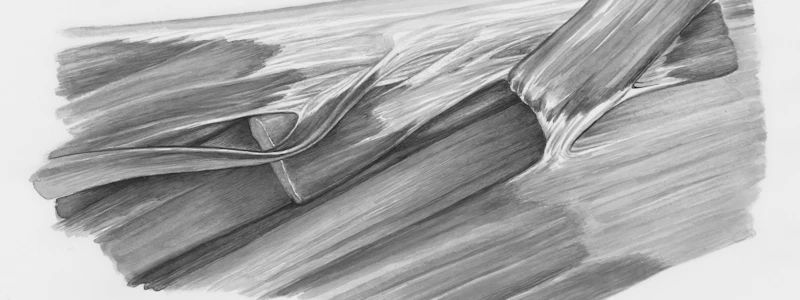Podcast
Questions and Answers
What is the primary function of astrocytes in the central nervous system?
What is the primary function of astrocytes in the central nervous system?
- Support neurons and maintain the blood-brain barrier (correct)
- Conduct electrical impulses
- Act as immune cells
- Generate myelin
Which type of muscle fiber is characterized by rapid contraction and high force generation?
Which type of muscle fiber is characterized by rapid contraction and high force generation?
- Type II fibers (correct)
- Slow oxidative fibers
- Type I fibers
- Fast oxidative-glycolytic fibers
Which adaptation is typical of slow twitch muscle fibers?
Which adaptation is typical of slow twitch muscle fibers?
- Rapid fatigue
- High myoglobin content (correct)
- Low mitochondrial content
- High anaerobic capacity
What role do Schwann cells play in the peripheral nervous system?
What role do Schwann cells play in the peripheral nervous system?
Which activity would primarily utilize slow twitch muscle fibers?
Which activity would primarily utilize slow twitch muscle fibers?
What is the primary function of loose connective tissue?
What is the primary function of loose connective tissue?
Which type of muscle tissue is characterized by striated, branched fibers and is responsible for involuntary pumping of blood?
Which type of muscle tissue is characterized by striated, branched fibers and is responsible for involuntary pumping of blood?
What occurs during the power stroke of muscle contraction according to the sliding filament theory?
What occurs during the power stroke of muscle contraction according to the sliding filament theory?
Which connective tissue type is known for providing strong, fibrous support and includes tendons and ligaments?
Which connective tissue type is known for providing strong, fibrous support and includes tendons and ligaments?
What is the primary role of adipose tissue in the body?
What is the primary role of adipose tissue in the body?
What is the function of blood as a connective tissue?
What is the function of blood as a connective tissue?
Which structural component of neurons is responsible for transmitting signals away from the cell body?
Which structural component of neurons is responsible for transmitting signals away from the cell body?
What type of cartilage is found in intervertebral discs and is known for its shock-absorbing properties?
What type of cartilage is found in intervertebral discs and is known for its shock-absorbing properties?
Flashcards
Connective Tissue
Connective Tissue
Tissue that supports, structures, and insulates the body. Examples include loose connective tissue, dense connective tissue, cartilage, bone, adipose tissue, and blood.
Areolar Tissue
Areolar Tissue
A type of loose connective tissue that provides support, elasticity, and allows for the diffusion of nutrients. Found throughout the body.
Tendon
Tendon
Fibrous connective tissue that connects muscle to bone.
Ligament
Ligament
Signup and view all the flashcards
Hyaline Cartilage
Hyaline Cartilage
Signup and view all the flashcards
Sliding Filament Theory
Sliding Filament Theory
Signup and view all the flashcards
Neuron
Neuron
Signup and view all the flashcards
Muscle Tissue
Muscle Tissue
Signup and view all the flashcards
Astrocytes
Astrocytes
Signup and view all the flashcards
Microglia
Microglia
Signup and view all the flashcards
Fast Twitch Fibers
Fast Twitch Fibers
Signup and view all the flashcards
Slow Twitch Fibers
Slow Twitch Fibers
Signup and view all the flashcards
Myelin
Myelin
Signup and view all the flashcards
Study Notes
Connective Tissues
- Connective tissues provide support, structure, and insulation.
- Loose Connective Tissue (e.g., Areolar): Supports, offers elasticity, and facilitates nutrient diffusion.
- Dense Connective Tissue (e.g., Tendons, Ligaments): Strong, fibrous tissue crucial for tensile strength.
- Cartilage: Provides structural support in different forms:
- Hyaline: Found in joints, reducing friction.
- Elastic: Found in ear and epiglottis, offering flexibility.
- Fibrocartilage: Located in intervertebral discs, absorbing shock.
- Bone: Provides structural support and protection, storing calcium.
- Adipose Tissue: Stores energy, insulates, and cushions organs.
- Blood: Transports nutrients, gases, hormones, and waste.
Muscle Tissue
- Muscle tissue enables movement and comes in three forms:
- Skeletal Muscle: Striated, multinucleated fibers; responsible for voluntary movement, attached to bones.
- Cardiac Muscle: Striated, branched fibers with intercalated discs; involuntary, pumps blood in the heart.
- Smooth Muscle: Non-striated, spindle-shaped fibers; involuntary, found in walls of hollow organs (intestines, blood vessels).
Sliding Filament Theory
- Explains muscle contraction at a molecular level.
- Key Components: Actin (thin filament), Myosin (thick filament), Troponin/Tropomyosin (regulatory proteins), ATP (energy source).
- Steps in Contraction:
- Calcium release from sarcoplasmic reticulum.
- Troponin activation (calcium binding triggers tropomyosin shift, exposing actin binding sites).
- Cross-bridge formation (myosin heads bind to actin).
- Power stroke (myosin head pivots, pulling actin).
- ATP binding and detachment (ATP causes myosin release, resetting for another cycle).
- Relaxation (calcium pumped back, muscle relaxes).
Nervous Tissue
- Nervous tissue specializes in communication and control.
- Neurons: Conduct electrical impulses;
- Structure: Cell body (nucleus and organelles), Dendrites (receive signals), Axon (transmits signals).
- Neuroglia (Glial Cells): Support neurons and maintain the blood-brain barrier.
- Types: Astrocytes (support neurons, blood-brain barrier), Microglia (immune cells), Oligodendrocytes (CNS myelin), Schwann cells (PNS myelin).
Muscle Fiber Types
- Fast Twitch (Type II):
- Contracts quickly, high force, fatigue rapidly.
- Anaerobic metabolism, less mitochondria and myoglobin.
- Examples: Sprinting, weightlifting.
- Slow Twitch (Type I):
- Contracts slowly, low force, resistant to fatigue.
- Aerobic metabolism, high mitochondria and myoglobin.
- Examples: Long-distance running, cycling.
Diagrams to Study
- Sarcomere structure
- Neuromuscular junction
- Fast and slow twitch fiber comparison
- Nervous tissue structure (neuron and glial cells)
Studying That Suits You
Use AI to generate personalized quizzes and flashcards to suit your learning preferences.




